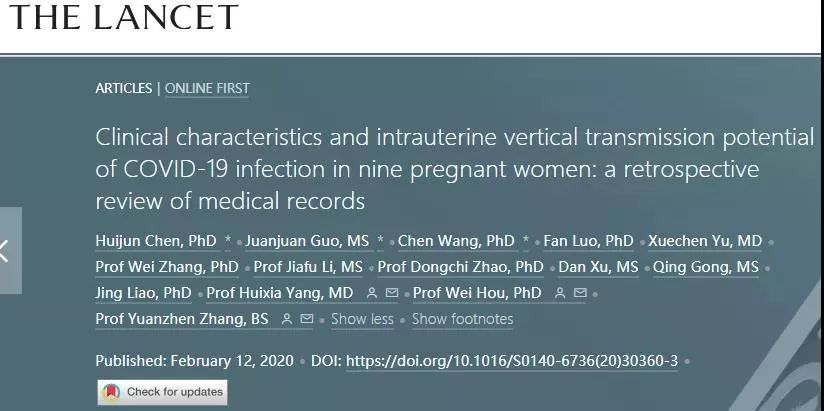Previous studies on the outbreak of pneumonia caused by Corona Virus Disease 2019 (COVID-19) are based on data of general populations, while the limited data of pregnant women with COVID-19 infection makes their clinical characteristics and vertical transmission potential remain unknown. On February 12, a paper was published online in an international top medicine journal The Lancet, with Zhang Yuanzhen, Hou Wei (both from Wuhan University) and Yang Huixia (Peking University) being the correspondent authors. The paper reveals no vertical transmission of SARS-CoV-2 will take place.

The paper is entitled Clinical characteristics and intrauterine vertical transmission potential of COVID-19 infection in nine pregnant women: a retrospective review of medical records. The study retrospectively analyzed clinical data of 9 pregnant patients diagnosed with COVID-19 infection in laboratories (Severe Acute Respiratory Syndrome Coronavirus 2 [SARS-CoV-2] from their throat swab samples had been tested positive), including the laboratory results and the CT scan of chests. They were admitted to Zhongnan Hospital of Wuhan University from January 20 to January 31, 2020. Intrauterine vertical transmission is to be proved by the existence of SARS-CoV-2 in cord blood after the amniotic fluid test. The study reveals that clinical characteristics of pregnant COVID-19 patients are similar to those of non-pregnant adult patients. Results acquired from this small group of cases show no evidence so far that vertical transmission would cause intrauterine infection for pregnant COVID-19 patients in their late pregnancy.
Meanwhile, Academician Qiao Jie from Peking University published a review entitled What are the risks of COVID-19 infection in pregnant women? online in The Lancet. In this article, Qiao gave a systematical summary on the above-mentioned research findings. He also proposed that laws and regulations ought to come out to enhance the emergency response competence to the outbreak of acute infectious diseases. Therefore, the prevention from and control of the spread of infectious diseases can be possibly avoid the outbreak in families, communities and other public places and more importantly, in a transparent and integrate way. He also stressed the importance to report newly-developed infectious diseases in time to avoid delayed reactions. Moreover, efforts should be made to bring infection under control and maintain management orders in hospitals and other places, put confirmed cases under quarantine together and offer special clothing and devices to protect medical professionals and other health workers from occupational COVID-19 infection.

COVID-19 is a highly infectious disease, and WHO has declared its continuous outbreak as Public Health Emergency of International Concern (PHEIC). COVID-19 was firstly reported in Wuhan, and broke out in Hubei Province of China in December 2019 and other parts of China afterwards.
A study in The Lancet reported epidemiological, clinical, laboratory and radiological characteristics, and treatment and clinical outcomes of COVID-19 patients confirmed in laboratories. However, the report was mainly targeted at non-pregnant adults, leaving clinical characteristics and vertical transmission potential of COVID-19 infection among pregnant women unknown. Urgent issues to be discussed and their solutions include: whether pregnant COVID-19 patients bear obvious symptoms that non-pregnant adult patients do not have; whether they are at higher risk of dying from infection or giving premature birth? whether COVID-19 can be transmitted vertically and bring risks to the fetus and newborn? The answers are vitally important for developing principles of obstetric treatments of pregnant women infected by COVID-19.
Hence, to more effectively prevent and control COVID-19 among children and pregnant women in China and even around the globe, the study retrospectively collected and analyzed detailed clinical data of pregnant women infected by COVID-19 from Zhongnan Hospital. In the study, researchers introduced clinical characteristics of pregnant women infected by COVID-19, and studied vertical transmission potential of COVID-19.
In this study, all the 9 patients have a caesarean section in their late pregnancy. Seven patients have had a fever, and other symptoms have been observed, including cough (4 cases out of 9), myalgia (3 cases), sore throat (2 cases) and discomfort (2 cases). Fetal distress has been monitored in 2 cases. Five patients out of 9 have suffered from lymphopenia, and 3 patients have seen an increase in their aminotransferase concentration.
No patients have fallen seriously ill or died by February 4, 2020. Nine live births have been recorded, and no newborn asphyxia has been observed. Among all the 9 live births, 1-minute Apgar scores are 8-9, and 5-minute Apgar scores are 9-10. SARS-CoV-2 tests have been conducted on amniotic fluid, cord blood and breastmilk samples of six patients and throat swab samples of their newborns, and all samples have been tested negative.
Rewritten by: Liu Xinfan
Edited by: Cao Siyi, Shen Yuxi and Hu Sijia